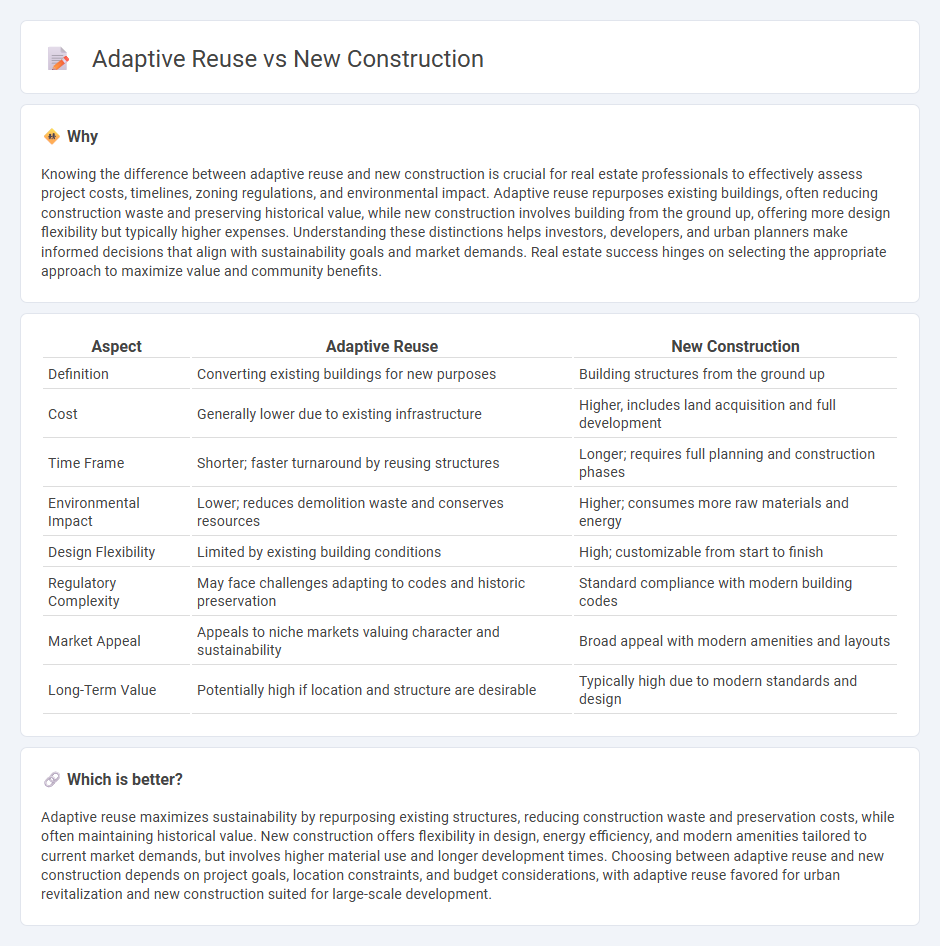
Adaptive reuse transforms existing buildings into functional spaces, preserving architectural heritage while reducing environmental impact and construction costs. New construction allows customization and modern design tailored to current needs but often involves higher expenses and longer development timelines. Explore the benefits and challenges of adaptive reuse versus new construction to determine the best strategy for your real estate project.
Why it is important
Knowing the difference between adaptive reuse and new construction is crucial for real estate professionals to effectively assess project costs, timelines, zoning regulations, and environmental impact. Adaptive reuse repurposes existing buildings, often reducing construction waste and preserving historical value, while new construction involves building from the ground up, offering more design flexibility but typically higher expenses. Understanding these distinctions helps investors, developers, and urban planners make informed decisions that align with sustainability goals and market demands. Real estate success hinges on selecting the appropriate approach to maximize value and community benefits.
Comparison Table
| Aspect | Adaptive Reuse | New Construction |
|---|---|---|
| Definition | Converting existing buildings for new purposes | Building structures from the ground up |
| Cost | Generally lower due to existing infrastructure | Higher, includes land acquisition and full development |
| Time Frame | Shorter; faster turnaround by reusing structures | Longer; requires full planning and construction phases |
| Environmental Impact | Lower; reduces demolition waste and conserves resources | Higher; consumes more raw materials and energy |
| Design Flexibility | Limited by existing building conditions | High; customizable from start to finish |
| Regulatory Complexity | May face challenges adapting to codes and historic preservation | Standard compliance with modern building codes |
| Market Appeal | Appeals to niche markets valuing character and sustainability | Broad appeal with modern amenities and layouts |
| Long-Term Value | Potentially high if location and structure are desirable | Typically high due to modern standards and design |
Which is better?
Adaptive reuse maximizes sustainability by repurposing existing structures, reducing construction waste and preservation costs, while often maintaining historical value. New construction offers flexibility in design, energy efficiency, and modern amenities tailored to current market demands, but involves higher material use and longer development times. Choosing between adaptive reuse and new construction depends on project goals, location constraints, and budget considerations, with adaptive reuse favored for urban revitalization and new construction suited for large-scale development.
Connection
Adaptive reuse and new construction are interconnected strategies in real estate development that optimize land use and preserve architectural heritage. Adaptive reuse transforms existing structures into modern functional spaces, reducing environmental impact and construction costs compared to new construction. Both approaches address urban growth by integrating sustainability and meeting evolving market demands for residential, commercial, and mixed-use properties.
Key Terms
Zoning Regulations
Zoning regulations significantly influence the feasibility of new construction and adaptive reuse projects, often dictating building height, density, and land use types. New construction must comply with current zoning codes, which may restrict design flexibility, whereas adaptive reuse can exploit existing nonconforming uses but faces challenges in meeting updated safety and accessibility standards. Explore detailed zoning considerations to determine the optimal development approach for your project.
Building Codes
Building codes for new construction require adherence to the latest safety, energy efficiency, and accessibility standards, often involving stricter regulations than older buildings. Adaptive reuse projects must balance compliance with current codes while preserving existing structural elements, leading to potential variances or exceptions under local building regulations. Explore the nuances of building codes in new construction versus adaptive reuse to optimize your project's design and compliance strategy.
Historic Preservation
New construction often provides modern amenities but can disrupt the historic character of a neighborhood, whereas adaptive reuse preserves architectural heritage while integrating contemporary functionality. Adaptive reuse leverages existing building materials and design elements to maintain cultural significance and reduce environmental impact, aligning with sustainable preservation goals. Discover how balancing new development and historic preservation can enhance urban landscapes by exploring adaptive reuse strategies in detail.
Source and External Links
New Homes in Frisco, TX - The Grove Frisco offers new homes from some of the best builders in the country, including Brookfield Residential, Highland Homes, and Chesmar Homes, with a variety of floorplans available.
New Homes for Sale in Frisco, Texas - M/I Homes provides new-build homes with sustainable construction processes and energy-efficient materials in Frisco, TX.
New Construction Homes in Frisco TX - Zillow offers a platform to explore new construction homes in Frisco, TX, including floor plans and community details.
 dowidth.com
dowidth.com